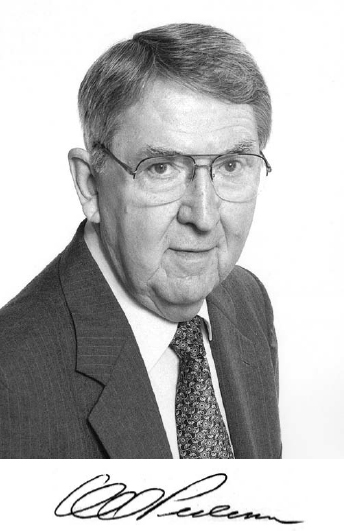1925–2004
Elected in 1974
“For leadership in integrated circuits research and
innovation in related computer-aided design.”
BY PAUL R. GRAY, DAVID A. HODGES, AND
A. RICHARD NEWTON
Don Oscar Pederson was born on September 30, 1925, in Hallock, Minnesota. He entered Iowa State College in the fall of 1943 but was soon drafted. He served in Germany as a private in the U.S. Army from 1943 to 1946. After the war, he completed his undergraduate education at North Dakota Agricultural College (now North Dakota State University), where he earned a B.S. in electrical engineering in 1948. He earned master’s and doctoral degrees in electrical engineering from Stanford University in 1949 and 1951, respectively. After receiving his Ph.D., Pederson stayed on for a period as a researcher in Stanford’s electronics research lab. From 1953 to 1955, he worked at Bell Telephone Laboratories, in Murray Hill, New Jersey, and also taught night classes at Newark College of Engineering (now the New Jersey Institute of Technology).
Soon Don concluded that he enjoyed teaching even more than his work at Bell Laboratories. In 1955 he contacted acquaintances in California and subsequently was offered and accepted a position as an assistant professor at the University of California at Berkeley. He was an exciting and popular teacher, well remembered by generations of students. With colleague Ernest Kuh, he coauthored Principles of Circuit Synthesis (McGraw-Hill, 1959), a leading undergraduate text of its time. Later he authored another textbook, Electronic Circuits
(McGraw-Hill, 1965). His tenure at Berkeley included stints as director of the campus’s Electronics Research Laboratory and as vice chair and chair of the Department of Electrical Engineering and Computer Sciences. He retired in 1991.
The year 1959 marked the invention of the integrated circuit, changing the world of electronics. Don foresaw that dramatic reductions in the size and cost of electronics would become possible. He became the preeminent pioneer in university research and teaching on integrated circuits, now generally known as “microchips.” Don decided that to undertake research in integrated circuits and to teach students to design them, the university needed its own semiconductor fabrication facility. When he voiced this idea, he met a host of objections—building such a facility was too complicated; his group was made up of engineers, not chemists; the university had no money for expensive fabrication equipment; and the project simply could not be done. Ignoring the objections, Pederson, with Professors Tom Everhart, Paul Morton, and Bob Pepper and a group of graduate students, started designing the facility. “Never wait for approval. Don’t tell anyone you are doing something. Just do it,” Pederson said later. “That’s my motto.”
Resourcefulness trumped the many difficulties. By 1962 the new facility was operational, producing publishable research and educating a new breed of engineers. Notable leaders from industry visited and praised the facility, the first microfabrication facility at a university. Graduates of the program soon became leaders in the semiconductor industry. Microfabrication capabilities at Berkeley have advanced and grown steadily ever since. As of 2006, several hundred students and faculty members from a wide range of academic fields had made use of this extremely flexible research facility.
In the mid-1960s, Don became interested in the application of computer aids to the analysis of integrated circuits. He and his students used a Bendix G15 minicomputer (the very one now displayed in the Smithsonian Institution’s Museum of American History) with only a typewriter and paper tape input and output, to try to gain a deeper understanding of the
behavior of certain circuit designs. Don became convinced that the computer would play a necessary role in the design and analysis of integrated electronics.
A decade of research, involving many undergraduate and graduate students, eventually produced the integrated circuit computer simulation program called SPICE (Simulation Program with Integrated Circuit Emphasis). The program allows engineers to analyze and design complex electronic circuitry with speed and accuracy. Virtually every electronic chip, developed anywhere in the world today, uses SPICE or one of its derivatives at critical stages during its design. Don and his students made many other contributions to electronic design automation along the way as well, in areas from device modeling, mixed-mode simulation, rule-based circuit diagnosis, to macromodels.
SPICE was one of the first significant open-source computer programs. The policy established by Don was that SPICE was available free of charge to any chip designer. The only request he made was that if a bug was found, or a new feature added, a copy should be sent back to Berkeley so that it could be made available to all other users. This policy accelerated the improvement of SPICE and its enhancement with many new features.
Soon after Don retired, former students and colleagues made substantial gifts to endow a professorship in his name and to pay for major renovations on the fifth floor of Cory Hall in a student area now identified as the “Donald O. Pederson Center for Electronic Systems Design.”
Don Pederson died on December 25, 2004, at the age of 79, of complications from Parkinson’s disease. He is survived by his wife of 27 years, Karen; four children from his first marriage, to Claire Nunan—son John and daughters Katharine Rookard, Margaret Stanfield, and Emily Sanders; and four grandsons.
Don was elected to membership in the National Academy of Engineering in 1974 and to membership in the National Academy of Sciences in 1982. He garnered numerous other honors and awards, including a Guggenheim fellowship in 1968, an American Association for the Advancement of
Science fellowship in 1988, the Berkeley Citation in 1991, the Phil Kaufman Award from the Electronic Design Automation Consortium in 1995, and the Medal of Honor from the Institute of Electrical and Electronics Engineers in 1998. He also received an honorary doctorate from Katholieke Universiteit Leuven in Belgium.







